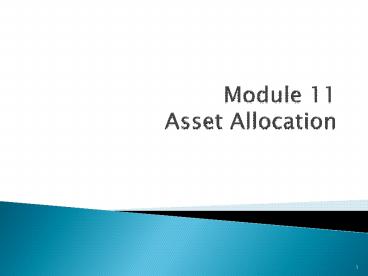Module 11 Asset Allocation - PowerPoint PPT Presentation
1 / 35
Title:
Module 11 Asset Allocation
Description:
Look at Certified Financial Planner website for tips on how: http://www.cfp.net ... Set goals and develop a life-long saving plan. Learn about returns and risk. ... – PowerPoint PPT presentation
Number of Views:21
Avg rating:3.0/5.0
Title: Module 11 Asset Allocation
1
Module 11Asset Allocation
2
Module 11 Learning Objectives
- Define asset allocation.
- List the asset classes and subcategories an
investor can select from. - Explain how asset allocation can maximize return
and reduce risk. - Explain rebalancing.
- Evaluate the asset allocation of a portfolio.
3
Asset AllocationTrue or false?
- Most investors hold a well-diversified portfolio.
- Humans were meant to stock pick.
- Investing will always be partly a guessing game.
4
Name all the asset categories you can allocate
into.
5
Consider the full menu of investments
6
Lets work on the best return first
7
Does more return mean more risk?
8
Does the risk double with two investments?
The key is having two investments which arent
correlated.
9
Adding a riskier investment to your portfolio
decreases overall risk.
10
If you allocate the right amount you reduce risk
and increase return!
11
Some investors think of risk as the maximum loss
they are willing to take. What does asset
allocation do for that?
12
You can reduce your maximum loss by diversifying.
13
Life Cycle Asset Allocation
14
Combining risk and return to get the most
efficient portfolio.
15
Bonds Risk Return
16
US Stocks Risk Return
17
Sectors Risk Return
18
International Risk Return
19
Combined Risk Return
20
- Calpers is the California pension system. Check
out their 2007 to 2008 target asset allocation
(available on their Web site www.calpers.ca.gov
under Investments). What differences do you see?
What does their target allocation suggest?
21
Pension Fund Portfolio
22
Millionaires Portfolio
23
David Swensen suggests a portfolio
24
Rebalancing
- Adjusting portfolio based on asset allocation
goals
25
Buy high, sell low
26
Rebalancing
- Determine what your asset allocation will be. For
example - 60 stocks
- 40 bonds
- Adjust your portfolio when your allocation
exceeds 5 difference from your target so that
you keep your asset allocation goals, that is 60
stocks and 40 bonds
27
No rebalancing
- If you didnt rebalance your portfolio, the
allocation of stocks would grow to 73 and the
allocation of bonds would shrink to 27
28
Rebalancing
- Rebalancing naturally sells high and buys low
- You end up with more gains
- It reduces the lows.
29
Protect your wealth.
30
- Safeguard all your financial information
- Keep good records and reconcile all your accounts
- Check your credit report
- If you feel that you have been a victim of fraud,
file a complaint with the DFI at 1-877-RING-DFI
or at their website www.dfi.wa.gov.
31
- Take time to pick an investment advisor who is
appropriate for you. Look at Certified Financial
Planner website for tips on how
http//www.cfp.net/ - Immunize yourself against investment fraud
check out all advisors and investments google
them and check with www.dfi.wa.gov
32
Let Uncle Sam help you save (taxes).
33
Use tax-advantaged saving
Check www.irs.gov Publication 590 for more
information.
34
Tax-advantaged education saving
- 529 Plans after-tax contributions, tax exempt
distributions if used for qualified educational
expenses - College savings plan
- Prepaid college tuition plan (Washington GET
www.get.wa.gov) - Coverdell after-tax contributions, tax exempt
distributions. Some restrictions.
35
Six steps to investing intelligently
- Set goals and develop a life-long saving plan.
- Learn about returns and risk.
- Evaluate your investments.
- Asset allocate.
- Protect your wealth.
- Use tax-advantaged saving.































